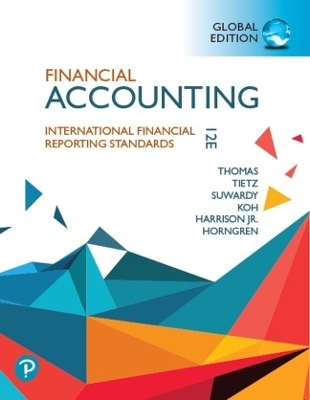
Prospective Financial Statement Analysis
John Wiley & Sons Inc
978-0-471-38336-9 (ISBN)
- Titel ist leider vergriffen;
keine Neuauflage - Artikel merken
An arsenal of powerful concepts, tools, and techniques for creating and analyzing all forms of prospective financial information Thanks to beefed-up demand for more prospective financial information coming from the AICPA, SEC, and IMA, an unprecedented wealth of new financial information is now available to those who know how to use it. Unfortunately, no standardized methods currently exist for analyzing this potentially useful information. How do you pull the important information from the mountain of figures now being generated? Just as importantly, how do you apply the results of your analyses to making sound investing and business decisions? Find out in Prospective Financial Statement Analysis. Providing a systematic approach to both the creation and analysis of prospective financial statements, this book offers a unique process model, a powerful engine that can be used to generate the most likely scenarios of future financial performance.
This model-which employs, among other things, state-of-the-art computer modeling techniques and sensitivity analysis-allows analysts to assemble and integrate data effectively from the five key analytic phases for analysis: qualitative analysis, quantitative analysis, strategic resource analysis, sensitivity analysis, and evaluation and conclusions. CPAs, financial analysts, venture capitalists, and all investment professionals will find this an indispensable tool of the trade!
FRANK J. KOPCZYNSKI, CPA, CMA, is the President of Business Planning Associates and an Associate Professor of Financial and Managerial Accounting at Plymouth State College. Business Planning Associates is a consulting firm specializing in financial and operational planning and control. He is a member of the board of editorial advisors for the AICPA's Journal of Accountancy as well as the board of directors of the New Hampshire chapter of the Institute of Management Accountants. He is also the author of several books on consulting and business planning.
Preface About the Author Chapter One Introduction 1.1 The Need 1.2 The Challenge 1.3 The General Approach 1.4 The Analyst 1.5 The Differences 1.6 Conclusion Chapter Two The Analysis of Prospective Financial Statements - The Process Model 2.1 Introduction 2.2 The Process Model 2.3. Phase 1 - Qualitative Analysis Step 1 - Establish the General Context Step 2 - Review the Strategic Plan Step 3 - Examine the Business Plan Step 4 - Define and Examine the Systems and Their Interrelationships Step 5 - Determine the Scope of the Examination Step 6 - Examine the Assumptions Step 7 - Review the Preparation and Presentation 2.4 Phase 2 - Quantitative Analysis Step 1 - Familiarization With and Review of Model Step 2 - Traditional Financial Analysis Step 3 - Discriminant (Bankruptcy) Analysis Step 4 - Valuation 2.5 Phase 3 - Strategic (Total) Resources Analysis 2.6 Phase 4 - Sensitivity Analysis Step 1 - Qualitative Sensitivity Analysis Step 2 - Quantitative Sensitivity Analysis Step 3 - Strategic (Total) Resources Sensitivity Analysis 2.7 Phase 5 - Evaluation and Conclusions 2.8 Summary Chapter Three Communication - The Foundation 3.1 Introduction Communication Theory Three Levels of the Communication Problem The Communications Model The Value of Information The Analyst's Role Accounting as the Language of Business 3.2 The Technical Aspect of Information Theory 3.3 The Semantic Aspect of Information Theory Meaning Language Indexing Word Shortening Latent Meaning Nonverbal Behavior Abstractive Relevance Information Distortion 3.4 The Effectivity Aspect of Information Theory Instruction Environment The Form of the Message The Transmittal System Knowledge About the Sources 3.5 Summary Chapter Four Accounting - The Framework 4.1 Introduction 4.2 To "Present Fairly in Conformity with GAAP" 4.3 Financial Statements 4.4 Conceptual Framework Objectives of Financial Statements Information Useful in Investment and Credit Decisions Information Useful in Assessing Cash Flow Prospects Information about Enterprise Resources, Claims to Those Resources, and Changes to Them Qualitative Characteristics 4.5 Structure of GAAP Basic Assumptions Business Entity Concept Going Concern or Continuity Concept Time Period Concept Stable Dollar Concept Basic Principles Historical Cost Principle Revenue Recognition Principle Expense Recognition Principle Matching Principle Consistency Principle Full Disclosure Principle Basic Modifiers Benefits Greater Than Costs Materiality Conservatism Industry Practices 4.6 Summary Chapter Five Prospective Financial Statements - The Standards 5.1 Introduction 5.2 Issuing Prospective Financial Statements Preparation Guidelines Presentation Guidelines 5.3 Accountant's Services on Prospective Financial Statements Compilations Definition Standards Procedures Working Papers Report Examinations Definition Basis for Reporting Planning Areas of Focus Extent of Procedures Procedures Working Papers Report Agreed Upon Procedures Procedures Working Papers 5.4 Illustrative Examination Procedures Procedures to Determine the Scope Procedures to Evaluate Assumptions Procedures to Evaluate Preparation and Presentation 5.5 Summary Chapter Six Strategic Planning - The Context 6.1 Introduction 6.2 Elements Objectives Strategists 6.3 Process Analysis and Diagnosis Environmental Analysis and Diagnosis Strategic Advantage Analysis and Diagnosis Choice Considering Strategic Alternatives Strategic Choice Implementation Leadership Implementation Functional Policy Implementation Organizational Implementation Evaluation 6.4 Reality 6.5 Strategic Planning and Business Plans Consistency with Operating Plans Investors How Is a Plan Read? The Lifecycle for Entrepreneurs Capital 6.6 Summary Chapter Seven Systems - The Reality 7.1 Introduction 7.2 The Systems View of the Firm 7.3 Elements of Systems Organizations Goals and Culture Structure Environment and Technology Control Open Systems Needs Traditional Accounting Control Process Behavioral Aspects of Control The Environment Information Demands Areas of Concern 7.4 Systems Perspective Unity General Systems Theory 7.5 Systems Design Process 7.6 Summary Chapter Eight Modeling, Forecasting, and Sensitivity Analysis - Some Tools 8.1 Modeling Introduction Types of Models Model Development Process Format Benefits Simulating Decision Making Financial Modeling and Qualitative Elements of Business Plans Model Integrity and Documentation Summary 8.2 Forecasting Introduction Systems Approach to Structuring Forecasting Problems Classification of Forecasting Methodologies Trends and Tradeoffs Summary 8.3 Sensitivity Analysis Introduction Objectives Testing Effects of Uncertainties in Parameter Values Generating Insight Directing Further Work on the Model Kinds of Sensitivity Types of Model Changes in Sensitivity Analysis Parameter Changes Structural Changes Parameter and Structural Changes Reasonable Versus Unreasonable Changes Interpretation Sensitivity Analysis During Modeling Model Experimentation Generating New Hypotheses Summary 8.4 Summary Chapter Nine Financial Analysis - The Basics 9.1 Introduction 9.2 Purpose Objectives Benchmarks and Comparisons 9.3 Approaches Horizontal Analysis Vertical Analysis Ratio Analysis Discriminant (Bankruptcy) Analysis Valuation Organization and Business Functions Analysis Systems Analysis 9.4 Elements and Ratios Liquidity Current Assets, Current Liabilities, and the Operating Cycle Current Assets Compared With Current Liabilities Other Liquidity Considerations Borrowing Capacity Income Statement Consideration When Determining Long--Term Debt--Paying Ability Balance Sheet Consideration When Determining Long--Term Debt--Paying Ability Special Items That Influence A Firm's Long--Term Debt--Paying Ability Profitability Profitability Measures Segment Reporting Gains and Losses That Bypass the Income Statement Interim Reports Investors Cash Flow 9.5 Computers and the Analysis Process 9.6 Interpretation 9.7 Summary Chapter Ten A Case Study - The Application 10.1 Introduction 10.2 The Case Study Overview Components of the Financial Model 10.3 Phase 1 - Qualitative Analysis Step 1 - Establish the General Context Communication Issues Accounting Information Step 2 - Review the Strategic Plan Step 3 - Examine the Business Plan Relationship to the Strategic Plan Organization and Provision for Business Functions Step 4 - Define and Examine the Systems and Their Interrelationships Step 5 - Determine the Scope of the Examination Step 6 - Examine the Assumptions Step 7 Review the Preparation and Presentation 10.4 Phase 2 - Quantitative Analysis Step 1 - Familiarization With and Review of Model Step 2 - Traditional Financial Analysis Determine Benchmarks and Targets Choose Approaches and Ratios Conduct the Analysis Step 3 - Discriminant (Bankruptcy) Analysis Step 4 - Valuation 10.5 Phase 3 - Strategic (Total) Resources Analysis 10.6 Phase 4 - Sensitivity Analysis Step 1 - Qualitative Sensitivity Analysis Step 2 - Quantitative Sensitivity Analysis Step 3 - Strategic (Total) Resources Sensitivity Analysis 10.7 Phase 5 - Evaluation and Conclusions Chapter Eleven Conclusion Appendix A Printout of Case Study Method Appendix B Printout of Case Study Quantitative Analysis Bibliography A Valuation B Marketing C Strategic and Business Planning D Computers E Finance F Accounting and AICPA Publications G Cost Estimating and Management Accounting H Systems and Operations I Quantitative Methods J Ethics and Business Responsibility K Communications and Logic Index
| Erscheint lt. Verlag | 4.7.2000 |
|---|---|
| Verlagsort | New York |
| Sprache | englisch |
| Maße | 147 x 226 mm |
| Gewicht | 425 g |
| Einbandart | Paperback |
| Themenwelt | Wirtschaft ► Betriebswirtschaft / Management ► Rechnungswesen / Bilanzen |
| ISBN-10 | 0-471-38336-8 / 0471383368 |
| ISBN-13 | 978-0-471-38336-9 / 9780471383369 |
| Zustand | Neuware |
| Haben Sie eine Frage zum Produkt? |
aus dem Bereich


